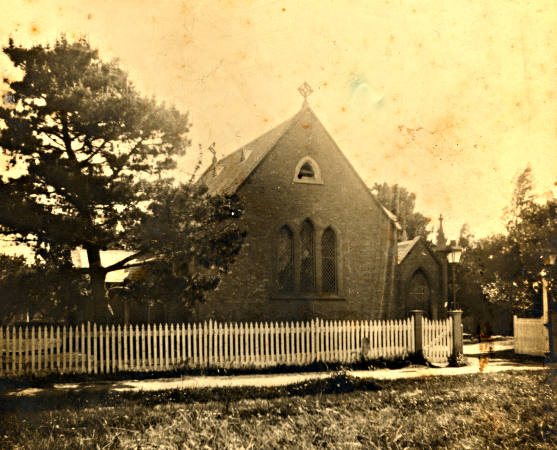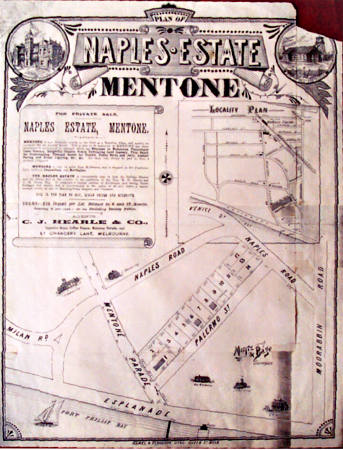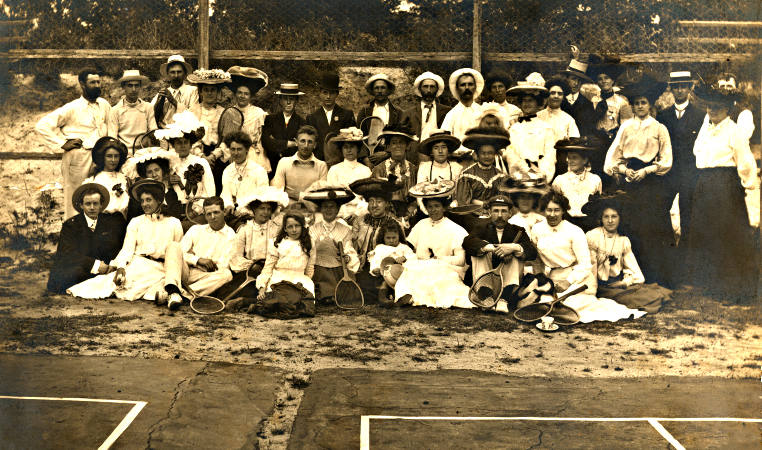The Two Hearles: Pioneers of Cheltenham and Mentone
The lives of Charles Jewell Hearle senior and Charles Jewell Hearle junior shared several features. Both were early pioneers in the Cheltenham Mentone district with both living there in the 1870s. Both were teachers, both were investors in land, both were involved in community affairs and both died at a relatively young age. But underlining these facts were marked differences. Hearle junior’s teaching career was much shorter than that of his father. Hearle senior was a lay reader at St Matthew’s, Church of England in Cheltenham while Hearle junior was a councillor in the Moorabbin Shire Council. Hearle junior’s land investments were much more extensive than those of his father and he experienced significant financial losses from these investments in the late 1880s. Hearle senior died at forty four years of age while his son was only twenty nine at the time of this death. Hearle senior died from natural causes while Hearle junior’s death may have been suicide.
Charles Hearle senior (c1825-1875), born in Frome in Somerset England, arrived in Melbourne with his wife, Emma (nee Johnson) on the Blackwall in November 1855, at the height of the gold rushes in Victoria. They had sailed from England on 14 July 1855 travelling in the Second Cabin. At that time his occupation in the shipping records was noted as clerk. [1]
By 1862 Heale senior was teaching at Melbourne Grammar School, remaining there until 1870. During this time, in 1866, he graduated from Melbourne University with a Master of Arts degree. (What Hearle was doing between his arrival in Melbourne and his appointment at the Grammar school was not discovered.)
Following his service at Melbourne Grammar he became a Senior Assistant, at the Training Institute in La Trobe Street, Melbourne. This institute was originally part of St James and St Paul’s Training Institution established by Richard Budd in 1857 under the Denominational Board for the preparation of teachers. [2][3][4] He remained a staff member there until 9 November 1875, the date of his death. He is buried in the Cheltenham Pioneers’ Cemetery [5]
While teaching at the training school he lived with his family in Williams Road Prahran and later at Hope Terrace in Gipps Street East Melbourne. A neighbour in Gipps Street was Dr John Singleton, the brother of the Rev William Singleton, the vicar of the Church of England at Cheltenham. [6] In 1873 Hearle sold the Williams Road property to Otto Mueller and moved with his family to a property identified then as being in Cheltenham. (now Beaumaris) The property consisted of eleven acres of land and at the time of his death included a twelve roomed wooden lath and plastered house. [7] Six acres had been purchased from George Lewis in July 1871 for £63, while the other five acres was bought from Peter Robert Taylor for £85 three months later. A further £1200 was spent erecting buildings and clearing and improving the land. To assist in financing the purchase of the property Hearle had received a loan of £300 from Mrs Anne Grover and surrendered the title deed as security. That same year, on 27 November 1873, Hearle was granted permission by the Shire Council to erect a bathing house on the beach.
It is interesting to conjecture why Hearle and his family of six children decided to settle in Cheltenham. [8] As a teacher in denominational schools he may have known Richard Hale Budd, a significant figure in the Denominational Schools Board, a resident of Sandringham and a very active layman in the Church of England churches in the district. Perhaps he raised the possibility of Hearle moving to Cheltenham. In addition Hearle’s neighbour in East Melbourne was the brother of the vicar of the Church of England in Cheltenham. Maybe he was involved in suggesting the possibilities of living with a large family in the newly developing district. Perhaps moving to Cheltenham presented an opportunity for Hearle senior to invest in land with the possibility of selling some of it later at a profit.

St Matthew’s Church of England, Cheltenham c1920. Kingston Collection, Courtesy Ida Reynolds.
Clearly, on arrival in Cheltenham, Charles Hearle quickly became involved with the local Church of England. He had been approved as a lay-reader and from March 1873 began taking Evensong and Matins services at Cheltenham for the Reverend William Singleton. In a short space of time he was conducting services several times a month and on the sudden death of Singleton in June 1875 was called upon again to assist the parish. This he did until his own death later that year. At his death he left his wife Emma the eleven acre property and a second piece of land, ten acres in size, on which was erected a small weatherboard cottage. This unimproved acreage was tilled by Thomas Jeffrey which was offered to him at £250 . Other assets held by Hearle at the time of his death included a life insurance policy, shares in Victorian Permanent Building and Investment society, shares in the Second Emerald Hill Building Society and in the Mutual Store Limited. There was also household furniture in the Cheltenham house, a buggy with horse and harness and two cows valued at £12.10. Three hundred and twelve pounds was owed to him by Otto Mueller who had purchased the Williams Road property in June 1873.
Charles Jewell Hearle junior, born 16 September 1861,was thirteen years nine months old when his father died. At sixteen he was appointed Pupil Teacher at St Peter’s, Lansdowne Street, Fitzroy. Despite having passed a series of exams necessary for promotion in the teaching service, and being assessed as a good teacher by a school inspector, he resigned in June 1880. He was three months short of his nineteenth birthday. [9]
In the 1880s Charles Hearle was heavily investing, using borrowed money, in the land boom that was impacting on the value of properties throughout Melbourne but particularly in Cheltenham, Mentone, Beaumaris and Sandringham. Prices of land were escalating, profits on investments were huge and fortunes were being made. Hearle as an auctioneer and estate agent was established in Mentone in 1884 and had an office at Normanby Chambers, Chancery Lane, Melbourne with Alan Grace. By 1887 he was working with Dixon and Keys as land, estate agents and general commission agents in the firm Hearle Dixon & Co. Dixon was managing the office at 436 Chancery Lane Melbourne, Keys was at Cheltenham and Hearle was at Mentone. [10]

Real Estate Advertisement for Naples Estate with C J Hearle & Co agent for the sale, c1888. Courtesy Mordialloc and District Historical Society.
That same year, 1887, Hearle married Emilie Julia Cowen at St Matthew’s Church of England, at Cheltenham. Emilie, the twenty year old daughter of a senior constable of police, was living at ‘Albany’ in Cheltenham. Charles was twenty five and living in Mentone. Treasurer of St Augustine’s Church of England, secretary of the Mentone Hotel Company, he was also a playing member of the Cheltenham Tennis Club. [11]

Members of Cheltenham Tennis Club. c1900. Courtesy Moorabbin Historical Society.
In 1886 a deputation waited upon Hearle asking permission to nominate him for the position of auditor in the Shire of Moorabbin. [12] This initiative was unsuccessful. Later that year Hearle was writing with some annoyance to the editor of the Brighton Southern Cross disclaiming the authorship of several reports published in that paper under the non de plumes of ‘La Trobe’ and ‘Our Special Correspondent’. The reports, presented in a very elaborate style of writing, concerned events in Cheltenham and Mentone. [13] Heale claimed he was unable to write in the flowery and ‘pathetic’ style of the unnamed correspondents, suggesting the style was more appropriate for the journals of North Queensland or the New Hebrides ‘where the talent would be appreciated’. [14]
Twelve months after this newspaper outburst a vacancy occurred on the Moorabbin Council in the West Riding electorate due to the resignation of Harold Sparks. [15] Hearle stood as a candidate campaigning as a sixteen year resident of the district whose work as an estate agent at Cheltenham and Mentone found him constantly moving through the district giving him an intimate knowledge of its roads and their condition. [16] His opponents were David Abbott and Edward Vail. Abbott, a wealthy land owner and solicitor of Sandringham, had already been a long time serving member of council. The local paper, the Leader, praised Hearle’s candidature saying: ‘Unless we are mistaken, this gentleman would make a councillor who would be an acquisition to any municipal body.’ [17] Again he was unsuccessful. However in August 1888 he gained a place at the council table.
Charles Hearle’s service as a councillor was relatively brief. On December 1889 he resigned to resume his career as a school teacher at Fraser’s Sawmill, Labertouche. (North of Longwarry) At his official farewell at the Mentone Coffee Palace in March 1890 it was said that Hearle, one of the oldest residents of the district was obliged to leave the district for the benefit of his health. Hearle thanked the gathering for the good feelings extended to himself and his wife and ‘trusted that before very long he would be returning to take his old place amongst them and if it was their desire, his old place in council’. [18] This was not to be. Twelve months later he was dead. He left a young widow and two young children: Charles Jewell three years and Ina seven months.
The Argus reporting Hearle’s death said it was enshrouded in mystery. [19] Charles Hearle was struck on the head by a train travelling between Trafalgar and Moe. The train driver at the inquest said he first saw the victim when he emerged from the scrub on his hands and knees and placed his head on the rail. The train was about fifteen yards from the victim when the driver applied the brakes and sounded the whistle. James Bretherton, a constable from Moe, described the injuries as two large bruises – one under the jaw and one behind the ear. He believed, from the loose way his head moved, that the neck was broken. There were no other blemishes on his body. However he noted, while the deceased was only 29 years of age, he ‘bore a very aged appearance’.
It emerged from the information presented at the inquest that Hearle had suffered serious financial losses with the collapse of the land boom. This was the principle reason why he took the position of head teacher at Labertouche where quietness and rest was possible. This business collapse probably was a major contributing factor to his deteriorating health. His brother-in-law, Arthur Franklyn, married to a sister of Charles Hearle, told the inquest that Hearle had received a severe injury to the head sometime earlier. Since then if he drank alcohol he couldn’t take care of himself. While he believed his brother-in-law had no wish to attempt self destruction, when under the influence of liquor his mind became completely unhinged.
Frederick Campbell, a sawmill hand who had known Hearle since his arrival at Labertouche, said Mrs Hearle had come to him on Sunday evening telling him that her husband had left home on Saturday morning and had not returned. Campbell traced Hearle to Drouin where he had some drink and remained at Dawe’s Hotel overnight. Hearle had left immediately after breakfast, but Campbell was unable to locate him.
The coroner, in his summary, expressed the view that the deceased was in a stupor who on seeing the train approach was so confused that he placed himself in danger. The coroner acknowledged that the train driver, the only witness of the event, verified that it was suicide. The jury, after an adjournment of eight minutes, decided that Charles Hearle had met his death in ‘a purely accidental manner’. [20]
The body of Charles Jewell Hearle was interred with his father in the Cheltenham Cemetery on 19 March 1891 with the service being conducted by the local Church of England clergyman, Rev Alfred Caffin.
At the time of his death Hearle, in partnership with Dixon held land at Mentone, Cheltenham, Sandringham and Myrniong. The land in Como Parade, Mentone had a weatherboard dwelling on it which was rented. Other land in Mentone was on the corner of Mentone Parade and Florence Street. The land at Cheltenham was six lots on the Charman Estate bounded by Weatherall Road, Sydney Street and Mackenzie Street. The property in Sandringham was two unimproved lots in Sims Street. The purchase of this land had been financed through loans from the Colonial Investment Company of Queen Street, Melbourne with security being provided by titles to the land. Other assets included life insurance, two thousand shares of £1 each in Como Land Company (which were valueless), 250 shares in the Mentone Hotel Company Limited paid up to five shillings (also worthless) and five shares in the Cheltenham Protestant Hall Company, (again of no value). In total Hearle’s estate liabilities exceeded his personal and real estate assets. [21] [22] A sad situation for his young widow, Emily, with two young children to support.
